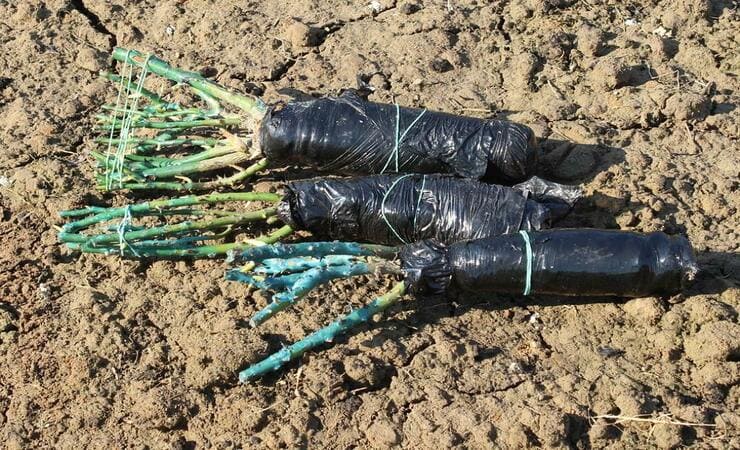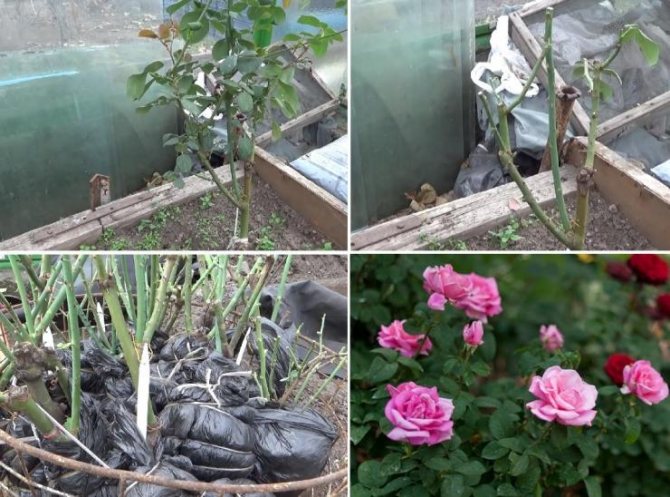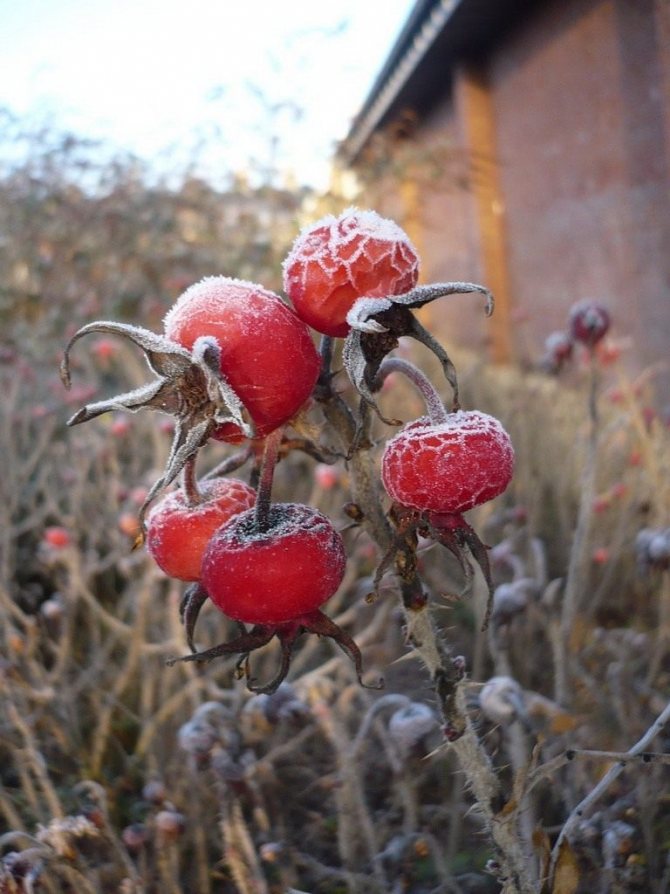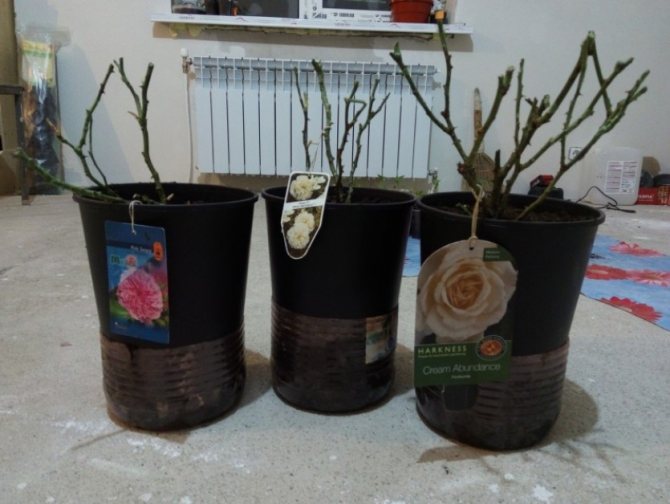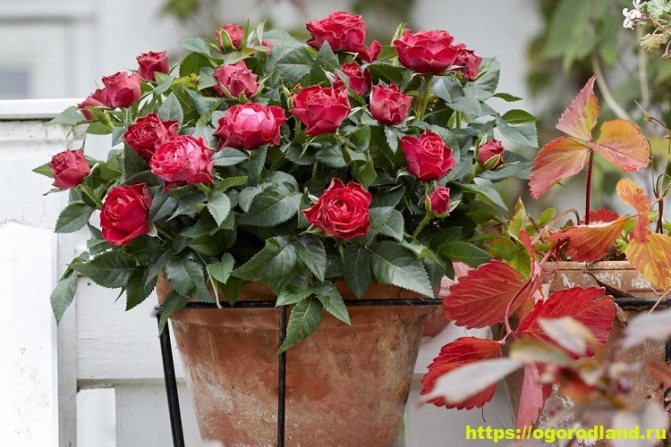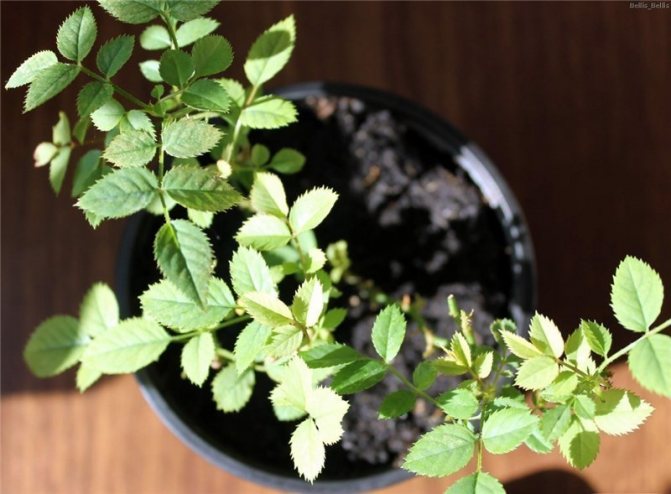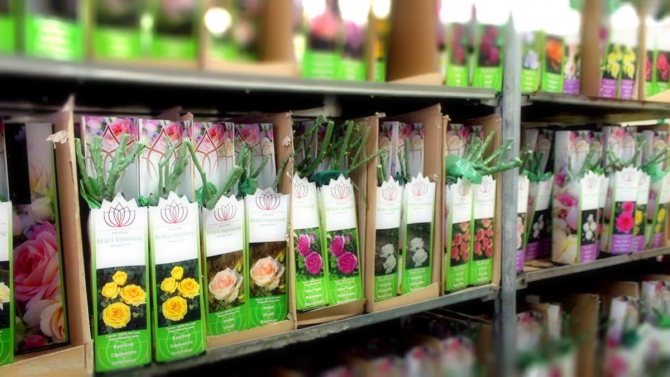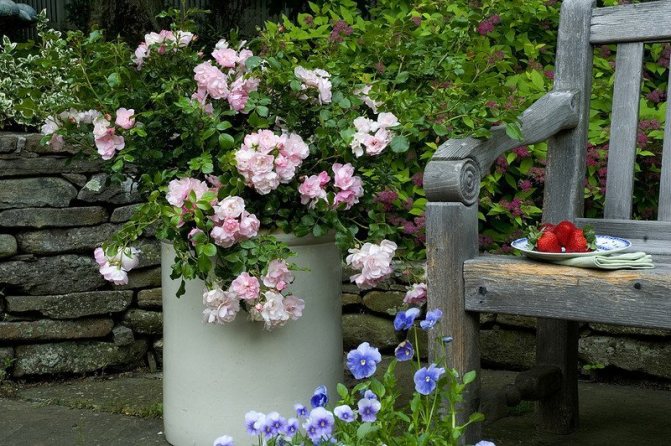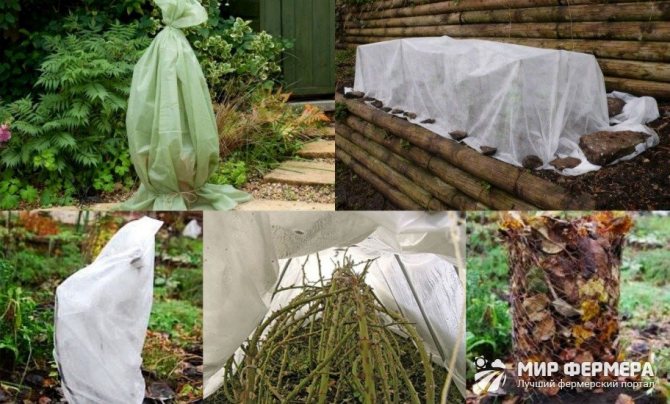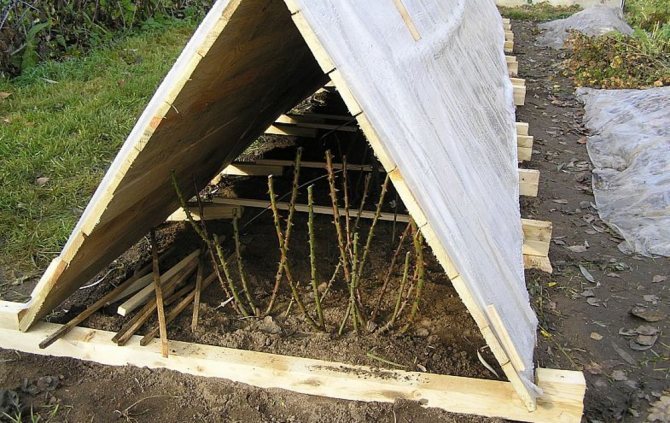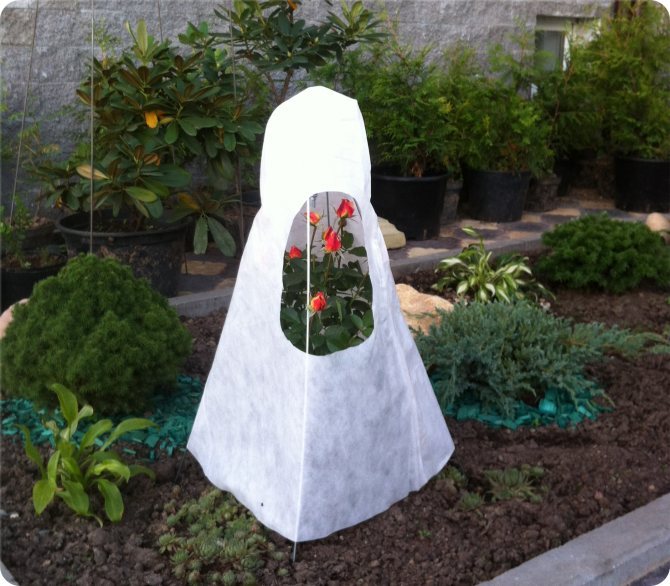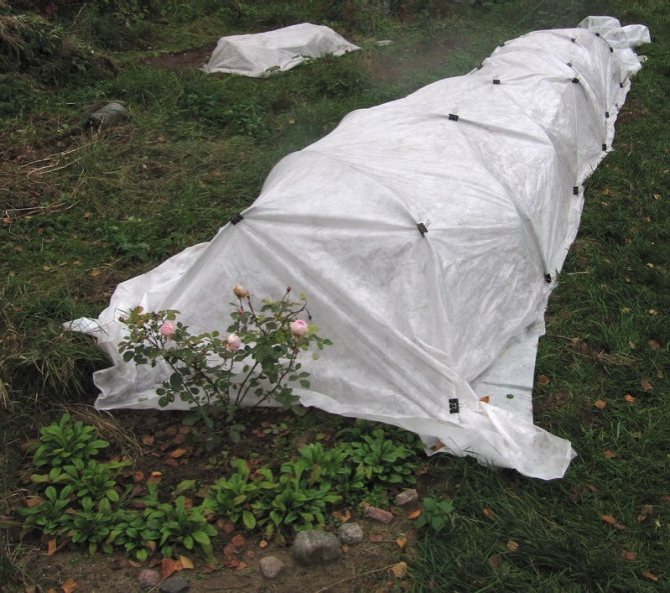Preparation
To save the bushes from freezing, start preparing for their storage at the end of September or after the first severe cold snap. Cut each shoot at a level of 0.3-0.7 m. The length that must be left depends on the age of the bush - the older it is, the more you should cut it. Make sure there are 8 to 10 buds left on each plant. After that, remove all the leaves from the bush and tie the twine around the branches. It is also recommended to spray all plants with insecticide and fungicide to prevent infections.
Now you can start digging up the roses. It is known that it is better to store slightly frozen bushes. Therefore, it is best to dig them out in dry weather, when the temperature drops to + 1-2 ° C at night. In wet weather, it will be difficult to clear the roots of soil clumps. If you can't wait out the rains, dig up and dry the bushes in a warm place for 1-2 days. This will help remove any excess soil.
If you need to transport roses or your basement is far away, tie a rope around the bushes (this will help prevent branches from breaking off).
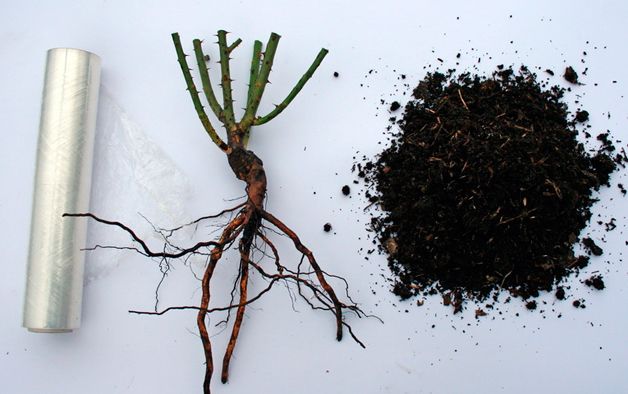
A seedling prepared for storage.
After digging up the roses, you must immediately dig up the soil in which they grew. If necessary, you can immediately treat the area with a weed killer. These measures will make it easier to plant the bushes in the spring.
The following are three of the most popular ways to store roses in winter.
- Application of containers with soil. Place the roots in plastic buckets or special containers. Several bushes can be placed in each bucket so that they stand tightly enough to each other. Fill all the free space with fertilized soil. Shake the container periodically during filling to completely cover the roots with soil. Finish with watering the roses. This method is convenient for those who plan to transport dug up roses.
- Adding sand. Many gardeners are convinced that it is best to keep plants in sand. The fact is that it retains moisture longer and prevents active growth even at elevated temperatures. Storage organization is carried out in the same way as with soil.
- Storage on shelves. If your basement is equipped with dedicated plant shelving, you don't need to use containers. To prevent the development of infectious diseases and decay, thoroughly wash and dry the racks before laying. Cover the shelves with wax paper and place the roses on top of them. Inspect them every 2-3 weeks and spray the roots with water when they are very dry.
Rooting in potatoes
You can also root cuttings of roses in potato tubers.
This is a fairly reliable method, as the nutrients and starch make them well accepted and reproduced. The tuber should be of medium size, without visible damage. It is treated with a fungicide and the eyes are removed. It is also necessary to prepare the cutting: remove a huge part of the leaves, lubricate the cut with potassium permanganate. It is great to put in aloe juice for 12 hours: this way the plant gets drunk with moisture, and the cut remains fresh. Growth catalysts can also be used. Then a recess is made in the potato, into which the cutting is placed.
Advice
The upper part can be sealed with paraffin by melting the candle in a water bath.
A tuber with a sprout is buried in a small opaque pot and watered with unsaturated potassium permanganate.
You can also put it in a bag and hang it on the window. In a couple of weeks, it will be noticeable that the kidney has begun to grow. In principle, water the cuttings of roses often. Once a week, it is better to feed with water and sugar; for this, a tablespoon of sugar is dissolved in a glass of water. A similar procedure will provide the sprout with carbohydrates. A month after planting, it is worth applying complex fertilizers.
Cuttings in a pot must be covered with a jar of a rather huge size so that the leaves do not touch the glass.
Watering should be of high quality, it is better to choose a drip spraying method. The soil must be slightly moistened at all times. As soon as the shoots appear, the roots will begin to develop. After two to three weeks, you should start accustoming the plant to open air. At first, the jar, which is covered with the sprout, is slightly raised and fixed in this position. The time of this procedure is evenly increased. Then it is quickly removed one hundred percent, just as slowly stretching these periods. When the flower gets used to an open airy place, the jar is removed for good. It can take several days.
You should not rush to plant from a pot. This must be done in the spring, then by the fall you can get a real bush.
When buds appear, they are removed.
VIDEO TO HELP:
Wintering in the basement or cellar
Plants are placed in the basement or cellar in early October. It is important that the temperature at the storage location is + 2-4 ° C, and the humidity is 90-95%. Under these conditions, the roses will not freeze, remain sufficiently moisturized and retain all their original properties. If it is more than + 5 ° С in the basement, they will continue to grow and bud.
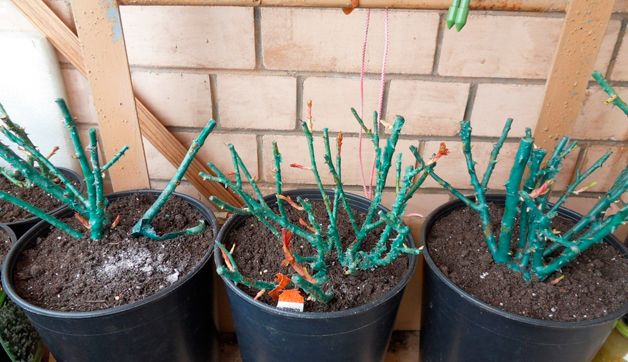

Seedlings in plastic containers with soil.
Also, the room temperature must not be allowed to drop below 0 ° C. This can lead to freezing of the soil and icing of the roots. In this case, you should immediately increase the humidity and temperature artificially using a film or other insulation. The protection should be removed at the first sign of warming.
If the temperature has exceeded + 5 ° С, it is necessary to immediately lower it. To do this, you can water the plants with cold water. You can also bring snow or ice into the room. They are laid separately from the bushes. If you pour snow between them, then the roses will quickly become covered with mold.
Remember that successful storage can only be carried out in a dry, clean and well-ventilated place. If there is mold, insects, or rats in the basement, do a thorough disinfection and cleaning first. Otherwise, the roses may get sick and not survive the winter.
Storage in the refrigerator and on the balcony
If for some reason you cannot organize storage in the basement, you should not give up growing roses. Indeed, in order to store them in winter, you can use a refrigerator or a regular balcony in a city apartment.
If your balcony or loggia is not insulated, and the average temperature on them is 0-5 ° C, you can store roses in the same way as in the basement. On an insulated balcony, the temperature in winter reaches 10-12 ° C. To prevent overheating, moisten roses once every 2 weeks with cool water and open windows more often. In this case, feeding is not necessary.
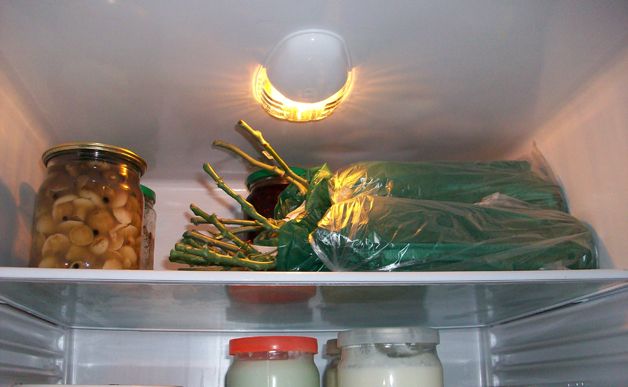

Storage of seedlings in the refrigerator.
Before you start storing roses in the refrigerator, make sure that it is set to the right temperature. In addition, the humidity in the refrigerator compartment should be 90-95%. After making sure that your performance is within the recommended range, pack the prepared bushes in plastic bags. Do not tie them too tightly, let the plant breathe freely.
Place the plants tightly against each other on the shelves. Open the bags once a month and check the roses for moisture and mold.If necessary, spray the roots with a spray bottle and remove mold with a soft brush or cloth. If the roses start to rot or show signs of infection, remove the bad plants immediately. In the future, monitor the storage conditions and condition of flowers more carefully.
Aunt Rosa, don't get sick!
| Cause | Symptoms | Rescue instructions |
| Spider mite | Thin cobweb on the back of the leaves. | The plant is treated with an onion solution prepared from 20 grams of husk and 1 liter of water. A day after the procedure, the leaves are washed with clean water. |
| Powdery mildew | The appearance of yellow spots that grow in size over time and turn brown. | Treat the leaves with a solution prepared from 2 tbsp. tablespoons of baking soda and 1 liter of water. The procedure is repeated every 14 days. When processing, be sure to cover the ground with a plastic bag. |
| Gray rot | Brown spots on the outlet and gray bloom. | Use Bordeaux liquid or Fundazol. |
| Aphid | The appearance of a light bloom on the leaves. | Wash the leaves with soapy water or treat with karbofos. |
Even a healthy plant needs prevention. To carry it out, add the onion broth to the irrigation water before feeding.
Planting bushes
Regardless of which way you choose to store the rose, the planting rules are the same. In the spring (on the twentieth of April), you need to get roses from the basement or refrigerator. Examine them carefully. If mold appears on the leaves or roots, carefully remove it with a cloth moistened with a weak solution of copper sulfate. If the storage was carried out correctly, the roses will have the first buds and young shoots.


Correct planting of the bush.
Remember to moisten the soil regularly before planting. Usually overwintered roses are planted in mid-May. If the weather is not warm enough, wait another 1-2 weeks.
Fertilize planting holes or dig up the ground by adding manure to it. Water the planted bushes immediately and loosen the soil around them slightly. Arrange top dressing 2 times in the first month after planting. At this time, roses will actively develop and give new buds. If you do everything right, then by mid-June they will bloom.
Thus, storing roses in winter requires a rather long preparation, but you will definitely like the result. Choose a storage method depending on your capabilities and follow all the recommendations given in this article. Beautiful and strong plants will delight you with their flowering for many seasons.
Agronomist-plant grower, site consultant on the cultivation and storage conditions of vegetables, fruits and mushrooms.
Blooming roses are considered one of the most beautiful ornamental plants. It is not surprising that many gardeners who do not have a personal plot tend to grow them on the balcony. Of course, for the successful cultivation of roses on the balcony, you should learn a few secrets.
Cropping rules in spring and autumn (with video)
Pruning climbing roses is the most important step in caring for mature shrubs in your garden. Such a procedure is necessary to form neat curtains and maintain the decorative effect of flowering. It is necessary to cut off dead and frostbitten shoots in the spring before the start of active growth, as well as in the fall in order to prepare the rose for wintering under cover. Let's find out how to form a bush, what are the nuances and rules, and also listen to the experts in the video who will tell you about the methods and options for this procedure.
Very young plantings that have not yet turned 3-4 years old may not need pruning of shoots. But, if the plant was grafted onto a rose hip, then it becomes necessary to remove the "alien" shoots of the root system before the appearance of its underground shoots. Rosehip produces very strong roots that can interfere with the normal development of climbing roses.


For crops that bloom once throughout the summer, pruning is carried out before wintering, cutting off all basal shoots at the root. Re-blooming roses are pruned twice - in spring and autumn. Until the age of 4-5 years, the plant does not require active shoot removal. Young crops up to 3 years old actively form buds on last year's stems. Only by the 5th year of life the ability to actively budding decreases, then pruning of old stems is required. In 4-year-old crops, the main shoots are cut to the base; for active flowering, the bush should have at least 1-3 annual and 3-7 flowering stems. Some varieties form buds only on "overwintered" shoots, this should be taken into account when choosing a seedling. In the spring, before the start of vegetative growth, the apical stems with underdeveloped buds are cut off from the bushes.
The video below shows how to prune a climbing rose in spring when growing a plant in a garden plot - what you need and how to do it correctly:
Variety selection
There are a huge number of varieties of roses in the world. First of all, your choice should be influenced by the climatic conditions in which these roses will grow. You should also decide on the space that roses will occupy from you.
Miniature
Miniature roses are easy to grow and care for, especially since they are ideal for growing on the balcony. You can grow them in hanging planters or in small railing pots. Miniature roses bloom very profusely and have a variety of colors: red, white, yellow, orange, etc. As a rule, the bushes are small, up to 40 cm, but very branched. The branches fall beautifully, creating a cascade of small, fragrant flowers.
Tea-hybrid
If you prefer large roses with a powerful bush, then your choice will fall on hybrid tea roses. Their flowers appear solitary on a long, straight and vertical stem, the length of which, depending on the variety, can reach 120 cm. Such roses are often used for cutting. They are among the most popular roses due to the variety of varieties and colors.
Floribunda
These are varieties of roses that have many small flowers on top of the stem. As a rule, such bushes are not very large and grow up to 60 cm.
Container selection
First of all, the container should be selected by size. You should not choose a container that is too large, which will only take up space. Also, the container must be sturdy with drainage holes in the bottom. Watering. Water after planting with plenty of water every day for a week. Then the watering can be reduced slightly. But do not forget that in summer the soil in containers dries out faster and it is necessary to increase the amount of watering.
Pot selection and transplanting
The container for roses should be at least 50-60 cm, since these flowers have deep roots and grow very quickly. The larger the tub, the more comfortable the rose will feel in it. In addition, the flower can be watered less often. The drainage holes in the tub play an important role. If they are not enough, you need to make additional holes yourself. Pebbles, gravel or expanded clay are well suited for drainage. A little sand can be poured into the ground.
To avoid fading the color of the pots on the balcony, it is better to choose containers of light shades. It is not recommended to choose metal tubs - they require thorough insulation due to good cold conductivity. Wooden or terracotta tubs are best suited for the balcony. When choosing plastic pots, it is worth focusing on containers with thick walls.


You should not start transplanting a plant immediately after purchasing it. Ideally, you first need to leave it for some time in the shade for adaptation, after sprinkling it with water, and only then start planting. With an open root system, you can place the roots of the seedling in water for a couple of hours. This will allow the roots to take root better and saturate them with moisture.
It is best to plant roses in spring.The roots of a young bush are very fragile, so you need to place the plant in new conditions very carefully. After moving the bush to fresh soil, it should be watered with settled water and removed for a couple of days in a place protected from direct sunlight and drafts. The plant needs to provide 3-4 hours of morning sun daily.
3-4 weeks after planting, you can make the first top dressing. The procedure must be done every 14 days until young shoots appear. Fertilize the plant during flowering. Fertilizers with a liquid consistency are well suited for this. In winter, roses are fertilized less frequently.
READ MORE: Growing geraniums on the balcony
Wintering roses on the balcony.
The first step is to prepare pots for wintering. They need to be insulated and mulched. If you have an open balcony with a strong draft, then it is better to move the pots indoors. It should not be an apartment or a house, as the temperature there is much higher than outside and the roses will wake up too early. Roses grow poorly and winter on the north side.
Care
It is necessary to cut off faded buds to stimulate flowering and for its abundance. Every spring, at the beginning of the growing season, the topsoil should be replaced with richer soil, it is possible with the addition of compost or manure. By following these simple tips, you can turn your balcony into a blooming garden filled with unique aromas.
A luxurious rose garden on the balcony is a real dream of many amateur flower growers. But sometimes you have to give up beautiful flowers with lush buds in favor of plants that are less capricious in care. Indeed, roses on the balcony require a special attitude, constant attention during the warm period, storage in the cold - that is, growing them is much more difficult than violets or even orchids.
Conditions for growing roses on the balcony
There are many examples of how well garden flowers take root in almost indoor - balcony conditions. Regular care and knowledge of the basics of floriculture pay off: home crops develop in the same way as species planted in open ground, bloom on time and open the buds until the very cold.
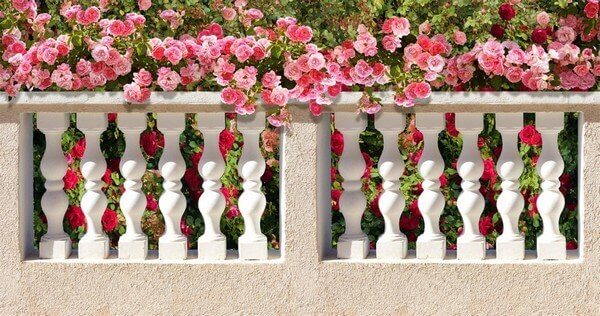

Magnificent flower garden on the terrace
Growing roses at home on the balcony primarily depends on the state of the room in which they will grow. They are thermophilic flowers, so the south and southwest sides are better than others. They love the sun, moderate doses of ultraviolet light will come in handy. However, the paradox is that in case of overheating, they immediately die. Therefore, cold northern directions are contraindicated for flowers, and special attention is required on the southern side.
Plants bloom wonderfully both on glazed and open balconies and terraces. The flowering period, as a rule, coincides with the warm season, and in summer, the climatic features of even the temperate and northern zones do not interfere with full-fledged development. Summer residents can tell a lot about how to grow roses on the balcony, because partially the conditions for caring for flowers in the ground coincide with the rules for growing balcony varieties.
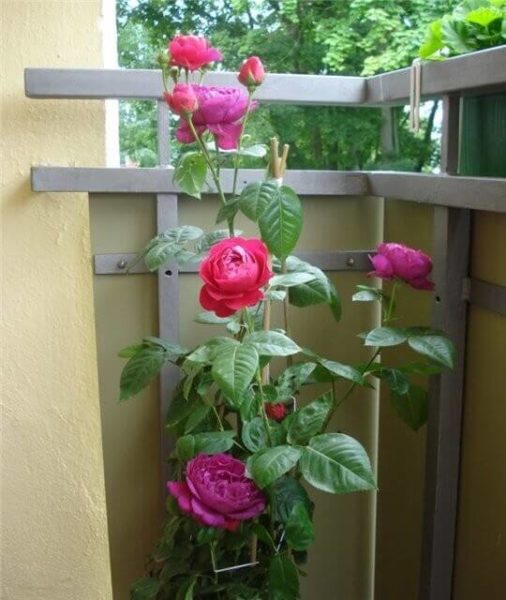

Rose bush on an open balcony
Are there any requirements for the thermal insulation of the premises? It all depends on the selected variety. The fact is that most of the shrubs endure the winter period in a "dormant" state, and this requires special conditions. A space warmed from all sides with an air temperature of + 18-22 ° C is not suitable, the flowers will shed their foliage and look painful. They will come to life only in the spring.
What types of roses are suitable for the balcony
Luxurious shrub growers are constantly experimenting with planting different species. It turns out that, subject to certain conditions and regular care, roses of both soil and indoor varieties grow equally well in pots on the balcony.
Tips for choosing flowering plants
When choosing a particular variety, you must remember the following nuances:
- Balconies and loggias are relatively small in terms of area of \ u200b \ u200bthe room, therefore, preference should be given to medium-sized shrubs. Miniature flowers look more appropriate, besides, it is much easier to care for them than for overgrown lush shrubs with heavy buds.
- It is best to select varieties that look good in outrigger trays, planters, and wall-mounted structures. Climbing roses with small inflorescences - up to 5 cm are suitable for decorating the walls of the loggia or the outer side of the balcony.
- Please note that due to the limited amount of soil, the root system of flowers does not fully develop, so the height of the stems may be less than usual.
- Single hybrid tea plants with large fragrant inflorescences are not suitable for planting in containers for fences or wall compositions. They are planted in large pots and placed on the floor. Low-growing varieties can be placed on a windowsill or on a table.
- Lush blooming floribundas can decorate any room, but these are some of the most capricious species that require constant attention.
- If you have no experience in growing, we recommend starting with ground cover varieties. They are undemanding to the watering regime and less demanding than large bush flowers. Having correctly planted decorative rabatkovye varieties, vertical surfaces (inner walls and the outer side of fences) can be turned into a thick, lushly blooming carpet.
Advice. So that the roses on the open balcony do not freeze in winter, and in the spring they start their flowering cycle safely, we recommend stocking up on varieties that have an ADR certificate. This marking was invented by the Germans in order to isolate the strongest, frost-resistant, disease-resistant lush plants from a huge assortment.
The best varieties according to reviews of experienced florists
Let's go directly to the individual species, which for many years delight lovers of lush bloom and allow you to create magnificent flower gardens on balconies, loggias and terraces.
A tea rose with the romantic name Nostalgie is a popular garden variety that can often be found in summer cottages. However, the lush two-color flowers were so fond of flower growers that they migrated from the ground to home conditions. Nostalgia is distinguished by its endurance, tolerates sharp rises or falls in temperature and reaches 1-1.1 m in height (at home, slightly below normal).


Nostalgia at the time of bloom
Floribunda Rouge Meilove is a delightful member of the rose family. A bright burgundy shade of buds (up to 7-8 cm in diameter), dark green foliage, a neat shape of an adult bush (about 0.6 mx 0.6 m), a delicate aroma - absolutely all qualities are suitable for growing a plant in limited conditions as a natural decor. In addition, the shrub perfectly resists frost and flower diseases, and blooms for 5 months - until the strong autumn cold.


Rouge Meilaw - a bright combination of flowers and leaves
If you prefer snow-white inflorescences, we advise you to pay attention to the tea rose of the Annapurna variety, known for its magical aroma and petals that do not have extraneous shades. In a pot, it reaches 0.5-0.6 m in height, while it blooms profusely and continuously. The buds are large, lush, have up to 20-25 petals. The flower rarely gets sick and perfectly tolerates short-term frosts.
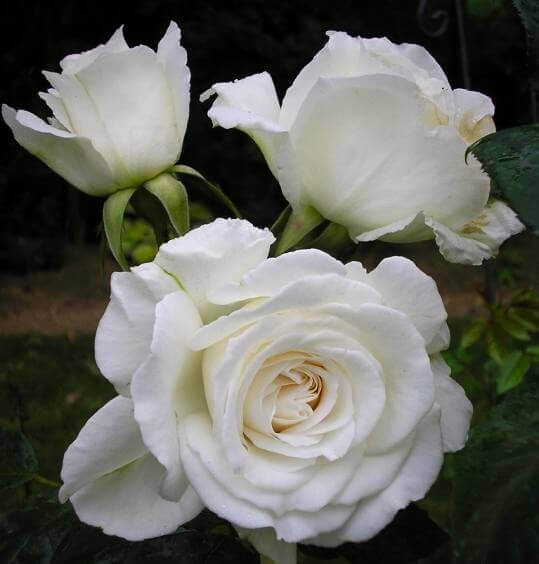

The boiling white color of Annapurna petals is difficult to confuse with other shades.
Among the bush species, Heidetraum stands out for its delicate shade and vigorous flowering. A short shrub (about 0.5-0.6 m in height) grows well to the sides, so it is better to prepare a wide pot or container for it. The plant has an amazing feature - the petals on old inflorescences do not fall off, but turn pale, becoming pale pink and light lilac. Thanks to this, the shrub has an attractive blooming appearance until mid-autumn.
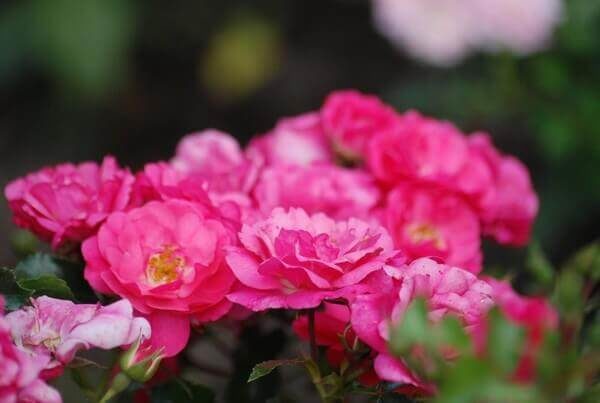

Lush bloom of Heidetraum
In addition to the listed representatives of the Rosaceae family, we recommend trying to plant the following varieties of garden roses in pots or containers on the balcony: Sonnenroeschen, Rotfassade, Apricot Meilove, Bambino, Gateway, Leona, Innocencia, Loredo, Gartnerfreude, Rosika.
Planting a climbing rose with cuttings and seeds
For planting climbing roses in the country, two seasons are favorable: autumn and spring (from early April to late May). This can be done with ready-made cuttings or seeds. The second case cannot avoid the seedling stage. To grow seedlings of a climbing rose in indoor conditions, sowing seeds should be done no later than the first decade of February. Otherwise, the seedlings will not have time to lignify enough by the time they are planted in the ground. Although experienced florists practice planting the seeds of a braided rose at the end of March, when the daylight hours are already quite long. All summer long the seedling is grown in a container, and planting in the ground is carried out in the fall.
Agricultural technology and its foundations in both versions are not very different, which cannot be said about the result. Climbing climbing roses planted in autumn develop much faster and have a higher immunity to various diseases. If you plant a plant in spring, then it will require a little more care, since it lags behind in development from autumn plantings by 2-3 weeks.
Climbing rose seedlings must be prepared before planting. In a few hours, the cuttings are placed in warm water, before that the shoots are shortened by 15-20 cm, and the rhizome by 20-30. We keep the seedling in the liquid for about a day before planting, then we remove the leaves and damaged areas on the plant. Be sure to treat all sections with crushed activated charcoal or charcoal for disinfection.
In a few days, they begin to prepare planting pits, between which there should be a distance of 1 meter. Depressions are dug out with parameters 50x50 cm. Removing the upper fertile layer, it is mixed with a bucket of manure, after which part of the mixture is poured and watered. The stalk of a climbing rose should be placed in the middle on a small tubercle of soil, the root system should be well spread and covered with soil. The top layer is compacted and watered with copious amounts of water. To preserve moisture in seedlings grafted onto rose hips, mulching with peat to a height of 15-20 cm is permissible. In this case, the grafting site should be 10 cm above ground level. The neck of young seedlings should look at least 5 cm from under the soil layer.


Spring plantings of a climbing rose are covered with a transparent film for some time. This is necessary to avoid exposure to cold wind and plant death. For a few minutes every day, the cap is opened, gradually increasing the time the roses are in the open air towards the warmth - this is how hardening occurs. As soon as the cold weather has passed, the film can be removed and the plant can be looked after as if it were an adult planting.
Look at the video - how to properly plant a climbing rose for growing in container and garden culture:
How to grow roses on the balcony
The cultivation of ornamental crops consists in the regular care of the plants, starting with the purchase of cuttings and ending with the preparation of flowers for the winter dormant period. Let's consider all the stages in turn.
Choosing the right pot and soil
If you have already decided on the variety, you need to find the most suitable containers among the dacha arsenal or purchase the most suitable containers in the store. Small flower pots for the windowsill will not work, it is worth starting from containers at least 0.4 m deep, and this is:
- flower pots for large plants;
- tubs, plastic and wooden;
- rectangular and square containers;
- decorative barrels;
- pots with legs and other containers of suitable size.
Please note that hybrid tea varieties with a meter height feel comfortable in tubs at least 0.4 cm in depth, and for other species it is better to prepare containers even deeper. For example, for bush varieties - at least 0.45 cm, and for climbing ones - at least 0.55 cm.


The pot seems large only at first.
The material of the pot can be anything: plastic, wood or ceramics, as long as it does not overheat in the sun. For this reason, for well-lit loggias, it is better to purchase pots and tubs of light shades.
Important! Drainage must be poured into the bottom of the container. Flowers are very hygrophilous, but stagnant water in pots can cause acidification of the soil or rot of the roots. Drainage is prepared in the usual way - from expanded clay, pebbles or rubble. A thin layer of bedding is closed from above with a non-woven membrane that is well permeable to moisture, but retains the soil.


Drainage from small stones and pebbles
Successful result
Factor # 1 - a healthy variety
The balcony is not really a room, but not a street yet. Flowers growing on a loggia are subject to constant changing conditions, so choose hardy and "stress-resistant" varieties.
The real exam for roses is the Allgemeine Deutschen Rosenneuheitenprüfung, abbreviated as ADR. What is it? This is a general test of new varieties, which is carried out in Germany. The presence of such a certificate in the variety indicates high winter hardiness, resistance to fungal infections, abundance and duration of flowering. These are the varieties that should settle on your balcony.
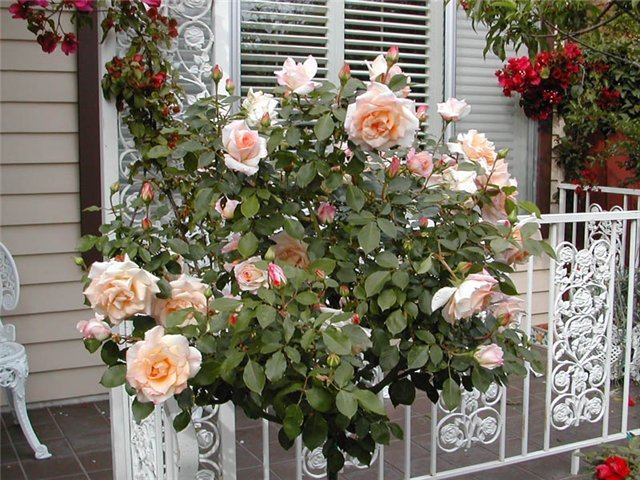

Choose varieties with ADR certification
Factor number 2 - not all roses are balcony
We can talk for hours and admire the roses on the gigantic bushes, but they will never become your balcony inhabitants. A simple example: I really love Advance roses, which reach a height of 5 meters, even the entire area of my balcony will not be enough for their greenery, in addition, they need a support and a large tub.
Well, the conclusion suggests itself - this variety is not suitable for home cultivation.
For the balcony, tea, rabatkovy and decorative ground cover varieties are suitable, which are quite unpretentious and ready to delight you with aroma, abundant and long flowering, even in areas modest in area.


Remember that not all varieties of roses are suitable for growing on the balcony.
Factor number 3 - the correct tub
Remember that roses have a deep root system, so you won't be able to get off with a shallow pot or tub. The height of the container must be greater than the width.
I would not even recommend looking towards pots below 40-50 cm.Yes, a young, only planted plant in such a large pot does not have a completely proportional appearance, but do not worry, the roses grow very quickly, after 2 months the bush will look more harmonious ...
The volume of the tub depends on the size of the root system of the bush: for hybrid tea varieties with a height below 1.20 m - at least 40 cm, for bush undersized (above 1.20 m) - 45-50 cm, for climbing - from 53 cm.
At the bottom of the tub, drainage must be laid, it can be fine gravel, expanded clay or pebbles. In addition, it is advisable to add a small amount of sand or expanded clay to the soil itself.
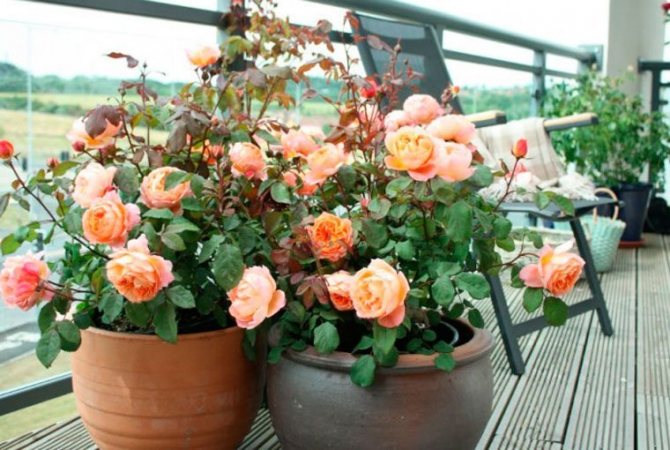

"Living space" for roses should be spacious
Another piece of advice that I had to get from personal bitter experience concerns the color of the plastic tubs. If the pots will be constantly exposed to the sun, choose light shades or shiny surfaces. These colors fade less, and tubs retain their presentable appearance longer.
The pot should have double or thick walls, if you have already purchased an unsuitable container, do not rush to get rid of it. You can insulate the "place of residence" from the inside with styrofoam.
Glazed wooden or terracotta pots are ideal. They are suitable for those for whom the price does not matter, and the balcony is a solid, reinforced structure.
In no case, do not purchase metal tubs, they conduct cold and heat very well, therefore they require high-quality insulation.


To place flowerpots on the balcony, purchase a frame basket
Factor number 4 - about watering
In order for roses to bloom profusely, I water them once a week, with a significant increase in temperature - every other day.
To determine the need for watering, immerse your finger in the ground 2-3 phalanges. Dry? Hurry for the watering can!
When watering, make sure that the soil is wet not only in the upper layers, but also at the bottom of the tub.
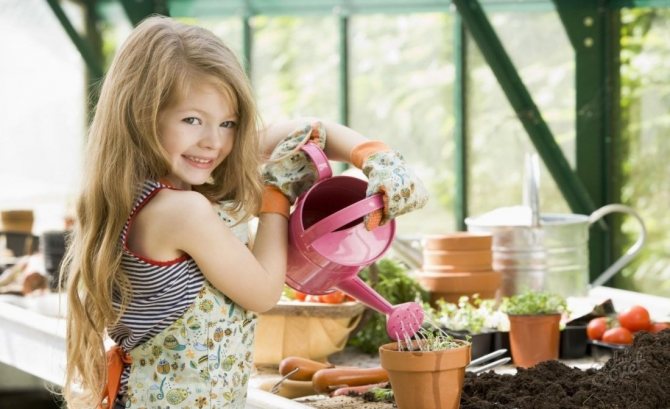

Watering - 1-2 times a week
Factor # 5 - ventilated place
The best growing conditions for roses are a well-ventilated, sunny place. On the balcony, this place is closer to the railing.
A calm and sunny place causes stress in plants, which spider mites feel perfectly well. Do you want uninvited guests on the balcony? Approach the issue of choosing a place with all responsibility.
Factor # 6 - how much sun do you need
Roses love light, but cannot stand high temperatures. The tubs are often not heated in direct sunlight, but rather from the reflective surfaces of the walls.
Roses, which bloom on the glassed-in balconies on the south side, require special attention. To avoid overheating, I place the tubs in boxes of soil or in a pan of water.
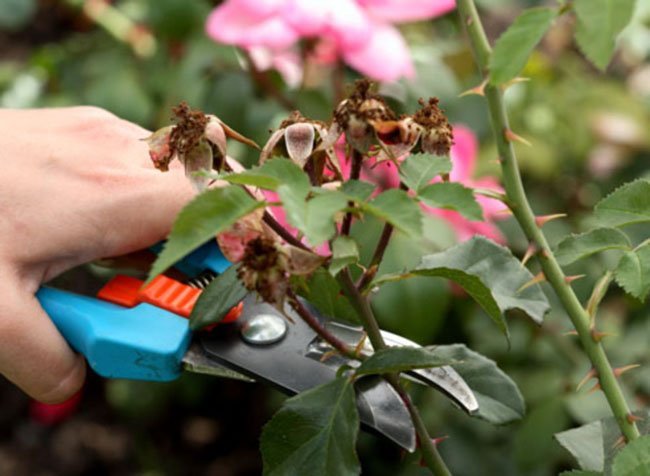

Dry pruning is a prerequisite for high-quality care for a balcony rose
Factor # 7 - remove faded flowers
The systematic removal of dead flowers allows the plant not to waste energy on seed formation. Roses are cut to the first leaf before they begin to shed their own petals.
Factor number 8 - wintering rules
If the rose will winter on the balcony, set it on a wooden stand, wrap the tub with bubble wrap, coconut mat or jute, and cover the shoots with a non-woven cloth. It is better for roses to winter in a shaded place near the wall.
With spring warming, do not rush to "undress" the roses, since sudden temperature changes can destroy young shoots.
Winter protection requirements
For the winter, roses plunge into a state of dormancy, do not bloom, accumulate strength for a spring breakthrough. If you bring them into the house and allow them to develop as usual, they will throw off the leaves and quietly wither away. Therefore, it is better not to argue with nature and think about how best to cover the roses for the winter on the balcony, in their usual environment. For pots or containers, a corner, a large wooden box, or a spot near a “warm” wall should be set aside.
There is no need to argue about the temperature at which roses should be stored on the balcony. It is believed that with good insulation, the flower easily tolerates cold temperatures down to -10 ° C, however, more attentive flower growers manage to preserve the plants in more severe conditions.
The most important condition for wintering roses on the balcony is a warm "cocoon" that covers the pot with the plant from all sides. For multilayer protection, use thick plastic wrap, old quilted jackets and jackets, wadded blankets and bags, spruce branches and jute rugs. Some craftsmen use all kinds of building membranes that create high-quality insulation.
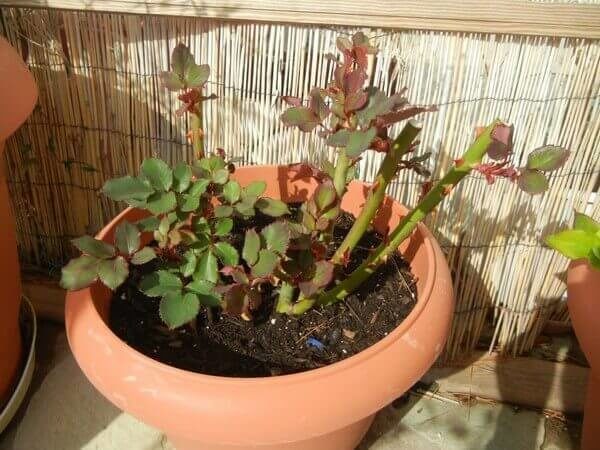

Spring preparation of the plant
However, do not forget that the plant, even in a dormant state, requires care and at least occasionally needs to be watered. Closer to spring, you can renew the soil, slightly "strip" the bush and treat it from pests.
Roses in pots Encyclopedia of roses
Dear rose growers! In the end, they opened a topic that bothered me for a whole year. Throughout the winter, I have been picking up roeas for the container. initially chose Gartnerfreude as it is a ground cover, but changed her mind about planting it in a container.
because it spreads and planted in a raised rocky flower bed, which I do not regret. I also bought a Blanc Meillan ground cover in Rusroso, by the way there are good roses there are inexpensive (I live next to the nursery and talked to the agronomist and found out that they receive seedlings from abroad, which they root for two years in pots and then sell it), too in a flower bed, although I see from the habitus that it is possible in a flowerpot. I have been picking up roses for my own 2 flowerpots for a long time, because the main condition is the height of up to 50 cm and the compactness of the bush.
I found it with difficulty, and even then not in Moscow (Yaroslavl, but orders go through Moscow and they leave delivery in Moscow) a charming Biedermeier rose, which at the moment is all strewn with tremendous non-falling flowers with its own small growth for a whole week !!! I will expose a photo when it is all strewn with flowers. My 2nd container rose is Heidi Klum Rose. Roses are extremely small in size and look charming, they stand at the pergola on the platform from 2 sides, like watchmen, and enliven the austere pergola. I love them already. Naturally, the pots are not plastic, but clay (painted in a snow-white color, since the black ones heat up) 30 liters each, purchased land on the basis of turf (not peat), sprinkled with vermiculite, against caking, to retain water and food.
I also added Apiona's long-lasting fertilizer (in sachets). For the winter I will put it in the garage (heated), but you can also add it in. My only concern is long rains, I'm afraid they will flood, but I’m at the dacha all summer and keep an eye on. For transportation, you can purchase a special. carts. The most important thing is to painstakingly select a variety (of course, not Ostinki, which bloom with a break), so that the eye and the heart will please.
Www. rosebook.
<
